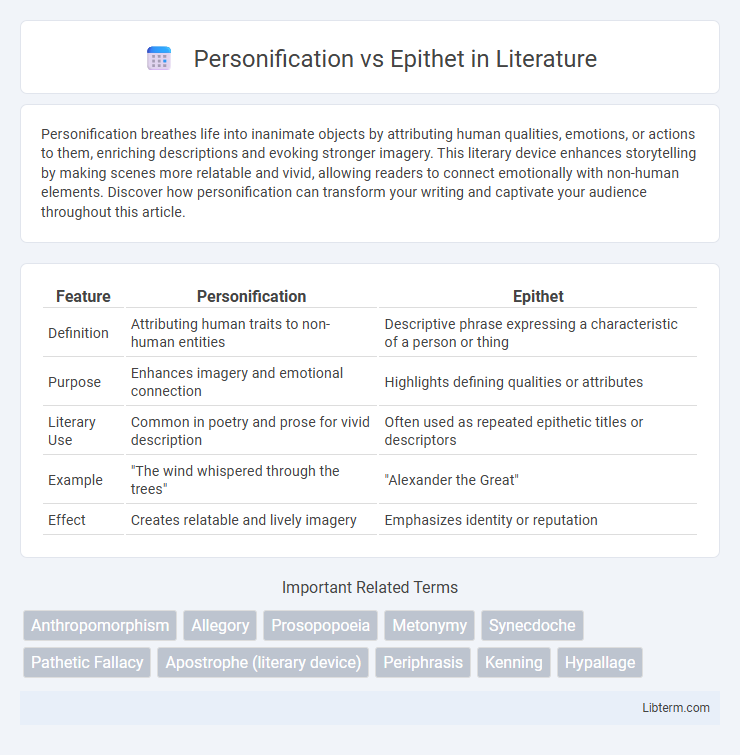Personification breathes life into inanimate objects by attributing human qualities, emotions, or actions to them, enriching descriptions and evoking stronger imagery. This literary device enhances storytelling by making scenes more relatable and vivid, allowing readers to connect emotionally with non-human elements. Discover how personification can transform your writing and captivate your audience throughout this article.
Table of Comparison
| Feature | Personification | Epithet |
|---|---|---|
| Definition | Attributing human traits to non-human entities | Descriptive phrase expressing a characteristic of a person or thing |
| Purpose | Enhances imagery and emotional connection | Highlights defining qualities or attributes |
| Literary Use | Common in poetry and prose for vivid description | Often used as repeated epithetic titles or descriptors |
| Example | "The wind whispered through the trees" | "Alexander the Great" |
| Effect | Creates relatable and lively imagery | Emphasizes identity or reputation |
Understanding Personification: Definition and Examples
Personification is a literary device that attributes human qualities or actions to non-human entities, such as objects, animals, or abstract ideas, enhancing emotional connection and vivid imagery. Common examples include phrases like "the wind whispered through the trees" or "time marches on relentlessly," where inanimate elements are given lifelike characteristics. This technique deepens readers' engagement by creating relatable and tangible expressions of complex or abstract concepts.
What is an Epithet? Key Characteristics
An epithet is a descriptive term or phrase expressing a characteristic quality of a person or thing, often used to highlight distinguishing traits. Key characteristics include its formulaic nature, association with a specific noun, and ability to create vivid imagery or emphasize particular attributes, such as "swift-footed Achilles" or "rosy-fingered dawn." Unlike personification, which attributes human qualities to non-human entities, epithets serve as concise modifiers enriching the meaning and emotional resonance of names within literary texts.
Historical Origins of Personification and Epithets
Personification originated in ancient Greek and Roman literature, where abstract qualities and natural forces were given human traits to convey deeper meaning in myths and poetry. Epithets also trace back to classical antiquity, notably in Homeric epics, where descriptive phrases like "swift-footed Achilles" emphasized key traits and aided oral storytelling. Both literary devices emerged as essential tools in early storytelling traditions to enhance characterization and thematic expression.
Function of Personification in Literature
Personification functions in literature by attributing human traits and emotions to non-human entities, enhancing vivid imagery and emotional connection for readers. This device animates abstract concepts, natural elements, or inanimate objects, making complex themes more relatable and engaging. Unlike epithets, which provide descriptive identifiers, personification actively transforms the narrative by breathing life into the non-human, enriching the text's expressive depth.
Epithet Usage in Classical and Modern Texts
Epithet usage in classical texts often involves attributive phrases that highlight a characteristic quality, such as "swift-footed Achilles," enhancing the narrative's vividness and aiding in oral tradition memorization. In modern texts, epithets serve to create concise, powerful imagery or convey nuanced traits, frequently employed in poetry and prose to evoke specific emotional responses or underscore thematic elements. While personification gives human traits to non-human entities, epithets focus on distinctly labeling characters or objects with descriptive adjectives that become closely associated with their identity.
Personification vs Epithet: Core Differences
Personification attributes human qualities to non-human entities, enhancing imagery by animating objects or ideas, while epithets are descriptive phrases or adjectives that highlight a characteristic or quality of a person or thing. The core difference lies in personification's dynamic representation of inanimate objects with life-like traits, compared to epithets' static, concise description emphasizing a defining attribute. Personification creates vivid emotional connections through storytelling, whereas epithets reinforce identity or themes through symbolic labeling.
Effects on Reader’s Perception: Personification vs Epithet
Personification enhances reader engagement by attributing human characteristics to non-human elements, making descriptions vivid and relatable, thereby evoking emotional responses. Epithet uses concise, descriptive phrases to highlight inherent traits or qualities, shaping reader perception by emphasizing particular attributes and adding layers of meaning. Together, these devices influence how readers visualize and connect with the text, either through emotional immersion or focused characterization.
Famous Examples of Personification in Poetry and Prose
Famous examples of personification in poetry and prose include William Wordsworth's depiction of daffodils "dancing in the breeze," which imbues nature with human qualities to evoke emotional resonance. In Emily Dickinson's poetry, death is often personified as a polite gentleman calling for a carriage, creating a vivid and intimate portrayal of mortality. These instances demonstrate how personification breathes life into abstract concepts, enhancing reader engagement and thematic depth in literary works.
Memorable Epithets in Mythology and Literature
Memorable epithets in mythology and literature serve as descriptive labels that encapsulate a character's defining traits, such as Homer's "Odysseus, the cunning" or "Achilles, swift-footed," providing clarity and reinforcing identity. Unlike personification, which attributes human qualities to non-human entities or abstract ideas, epithets function as concise, formulaic phrases that enhance narrative style and aid oral tradition. These carefully crafted epithets contribute to the enduring legacy of mythological figures by embedding personality traits directly into their names, enriching character portrayal and cultural memory.
Choosing Between Personification and Epithet in Creative Writing
Choosing between personification and epithet in creative writing depends on the desired emphasis and tone; personification attributes human qualities to non-human entities to evoke emotional connection, while epithets use descriptive phrases to highlight inherent characteristics succinctly. Personification enhances vivid imagery and emotional depth, making abstract concepts relatable, whereas epithets provide concise, memorable identifiers that reinforce character traits or themes. Writers should evaluate whether they aim to animate objects or qualities for immersive storytelling or emphasize specific attributes through precise, evocative language.
Personification Infographic

 libterm.com
libterm.com